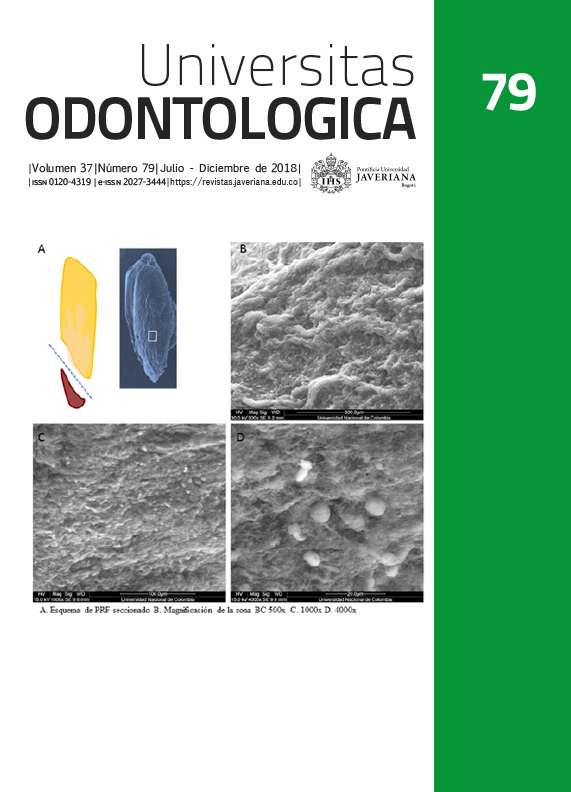Resumo
Antecedentes: As assimetrias mandibulares são consideradas variações morfológicas, que podem ser imperceptíveis ou ligadas a más oclusões, disfunções temporomandibulares e assimetrias faciais. Objetivo: Determinar a prevalência de assimetrias verticais mandibulares através de radiografias panorâmicas de pacientes atendidos no centro cirúrgico da Universidad Central del Ecuador utilizando a análise de Habets. Métodos: Descritivo e retrospectivo foi realizado para analisar radiografias panorâmicas de pacientes com idade maior que 15 anos que apresentavam dentição permanente completa e foram atendidos nos últimos 3 anos. A amostra consistiu em 680 radiografias de 309 homens e 371 mulheres, com uma idade média de 22,02 anos. O teste do qui-quadrado foi utilizado para analisar a associação entre as assimetrias encontradas para cada variável dependente e a idade e sexo dos pacientes. Os testes de Mann-Whitney e Kruskal Wallis foram realizados para analisar a distribuição das variáveis (intervalo de confiança de 95%, p <0,05). Resultados: A prevalência de assimetria condilar vertical foi de 70,3%, seguida por ramo (38,7%) e côndilo-espinho (30,7%). Houve uma tendência maior para o lado esquerdo. Conclusão: O índice de assimetria de Habets, com corte de 3%, apresentou maior prevalência de assimetria condilar, seguida de assimetria do ramo e assimetria do condilo-ramo. Esses valores não mostraram significância estatística em relação à idade e sexo.
Okeson JP. Tratamiento de oclusión y afecciones temporomandibulares. 7ma ed. Madrid España: Elsevier; 2013.
Sheikhi M, Ghazizadeh M, Salehi MM. Posttraumatic mandibular asymmetry presenting in a young adult. Radiology Case Reports. 2017; I(2): 73-77. doi:0.1016/j.radcr.2016.10.023.
Navarro C. Tratado de cirugía oral y maxilofacial. Tomo I. 2da ed. Madrid España: Arán; 2009.
Halicioğlu K, Celikoglu M, Buyuk SK, Sekerci AE, Candirli C. Effects of early unilateral mandibular first molar extraction on condilar and ramal vertical asymmetry. Eur J Dent. 2014 Apr-Jun; 8(2): 178-183.doi: 10.1007/s00784-012-0843-9
Kasimoglu Y, Tuna EB, Rahimi B, Marsan G, Gencay K. Condylar asymmetry in different occlusion types. Cranio. 2014 Jul; 0(0): 1-5. doi:10.1179/0886963414Z.00000000039
Alfaro C, Ayala R, Barrientos S, Rodríguez CA. Prevalencia de asimetrías mandibulares en radiografías panorámicas de población de Bogotá-Colombia. Int J Morphol. 2016 Ago; 34(4): 1203-1206. doi:dx.doi.org/10.4067/S0717-95022016000400004
Habets LL, Bezuur JN, VanOoij CP, Hansson TL. The orthopantomogram, an aid in diagnosis of temporomandibular joint problems. I. The factor of vertical magnification. J. Oral Rehabil. 1987; 14(5): 475-80.
Habets LL, Bezuur JN, Naeiji M, Hansson TL. The orthopantomogram, an aid in diagnosis of temporomandibular joint problems. II. The vertical symmetry. J. Oral Rehabil. 1988; 15(5): 465-71.
Sezgin OS, Celenk P, Aricic S. Mandibular asymmetry in different occlusion patterns. Angle Orthod. 2007; 77(5): 803-7). doi: doi.org/10.2319/092506-392
Arenas CS, Araya P, Palomino MH. Evaluación de la asimetría vertical mandibular, en pacientes con mordida cruzada posterior uni y bilateral. Int J Morphol. 2012, Jun; 30(3):883-890. doi: dx.doi.org/10.4067/S0717-95022012000300020
Fuentes R, Silva H, Sandoval P, Cuevas F, Rodríguez M. Altura del proceso condilar en pacientes con diferentes clases esqueletales que requieren tratamiento de ortodoncia. Int J Morphol. 2006 Sep; 24(3): 499-503. doi:10.4067/S0717-95022006000400033
Bezuur JN, Habets LL, Hansson TL. The recognition of craniomandibular disorders - a comparison between clinical, tomographical, and dental panoramic radiographical findings in thirty-one subjects. J Oral Rehabil. 1988; 15(6): 549-554. doi: https://doi.org/10.1111/j.1365-2842.1988.tb00191.x
Galarraga N. Motivo de consulta en el paciente ortodóncico adolescente. Acta odontol. venez. 2000; 38(1).
Van Elslande DC, Russett SJ, Major PW, Flores-Mir C. Mandibular asymmetry diagnosis with panoramic imaging. Am J Orthod Dentofacial Orthop. 2008 Aug; 134(2): 183-92. doi:10.1016/j.ajodo.2007.07.021
Kambylafkas P, Murdock E, Gilda E, Tallents RH, Kyrkanides S. Validity of panoramic radiographs for measuring mandibular asymmetry. Angle Orthod. 2006; 76(3): 388–93. doi: 10.1043/0003-3219(2006)076[0388:VOPRFM]2.0.CO;2
Devlin H, Yuan J. Object position and image magnification in dental panoramic radiography: a theoretical analysis. Dentomaxillofac Radiol. 2013; 42(1): 29951683. doi: 10.1259/dmfr/29951683
Larheim T, Svanaes D. Reproducibility of rotational panoramic radiography: Mandibular linear dimensions and angles. Am J Orthod Dentofacial Orthop. 1986; 90(1): 45-51.
Sanders D, Rigali P, Neace W, Uribe F, Nanda R. Skeletal and dental asymmetries in class II subdivision malocclusions using cone-beam computed tomography. Am J Orthod Dentofacial Orthop. 2010; 138(5): 542. e1-20. doi: 10.1016/j.ajodo.2010.02.027
Dawson P. Oclusión funcional: diseño de la sonrisa a partir de la ATM. Caracas Venezuela: Amolca; 2009.
Türp J, Vach W, Harbich K, Alt K, Strub J. Determining mandibular condyle and ramus height with the help of an orthopantomogram--a valid method J Oral Rehabil. 1996; 23(6): 395-400.
Este periódico científico está registrado sob a licença Creative Commons Atribuição 4.0 Internacional. Portanto, este trabalho pode ser reproduzido, distribuído e comunicado publicamente em formato digital, desde que os autores e a Pontifícia Universidade Javeriana sejam reconhecidos. Citar, adaptar, transformar, autoarquivar, republicar e criar novas obras a partir do material é permitido para qualquer finalidade (mesmo comercial), desde que a autoria seja devidamente reconhecida, um link para o trabalho original seja fornecido e quaisquer alterações sejam indicadas. A Pontifícia Universidade Javeriana não detém os direitos sobre os trabalhos publicados, e o conteúdo é de exclusiva responsabilidade dos autores, que mantêm seus direitos morais, intelectuais, de privacidade e de publicidade.



